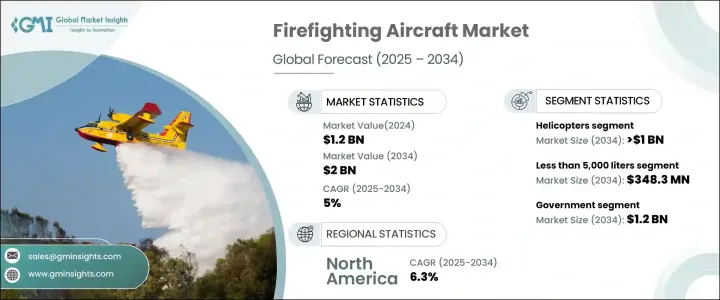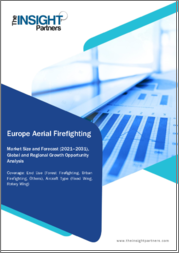
|
시장보고서
상품코드
1698314
소방 항공기 시장 기회, 성장 촉진요인, 산업 동향 분석, 예측(2025-2034년)Firefighting Aircraft Market Opportunity, Growth Drivers, Industry Trend Analysis, and Forecast 2025-2034 |
||||||
세계의 소방 항공기 시장은 2024년에 12억 달러를 창출했고 2025년부터 2034년까지 연평균 복합 성장률(CAGR) 5%를 나타낼 것으로 예측됩니다.
기후 변화는 산불 위험을 악화시키고 산불 시즌의 장기화와 효율적인 공중소화 솔루션에 대한 수요 증가로 이어지고 있습니다. 정부와 민간 기관은 화재 발생 시 신속한 대응과 효과적인 진압을 위해 첨단 항공기에 적극적으로 투자하고 있습니다.

이 시장은 헬리콥터, 고정익 항공기, 무인항공기로 구성되어 각각 화재 진압에 중요한 역할을 하고 있습니다. 점진적으로 소화하는 능력을 제공하기 위해, 소화 활동에 점점 더 임베디드되고 있습니다.
| 시장 범위 | |
|---|---|
| 시작 연도 | 2024년 |
| 예측 연도 | 2025-2034년 |
| 시작 금액 | 12억 달러 |
| 예측 금액 | 20억 달러 |
| CAGR | 5% |
정부 운영 소방 항공기는 화재 예방 및 재해 관리 전략에 대한 투자 증가로 2034년까지 12억 달러 규모에 도달할 것으로 예측됩니다. 이 시장은 산불 진압에 중요한 역할을 하는 정부 기관과 민간 계약업체로 세분화되어 있습니다. 이러한 기관은 특수 항공기를 배치하여 화재를 조기에 감지, 통제 및 진압함으로써 피해를 최소화하고 공공 안전을 보장하고 있습니다. 효율성의 향상, 비행 시간의 연장, 항공 지도 작성 능력의 강화 등을 특징으로 하는 선진적인 항공기를 도입해, 소방대를 근대화하기 위한 적극적인 대책이 취해지고 있습니다.
미국의 소방 항공기 시장은 2024년 3억 9,840만 달러에 이르렀고, 2025년부터 2034년까지 연평균 복합 성장률(CAGR) 6.3%를 나타낼 것으로 예상되고 있습니다.
목차
제1장 조사 방법과 조사 범위
제2장 주요 요약
제3장 업계 인사이트
- 생태계 분석
- 업계에 미치는 영향요인
- 성장 촉진요인
- 세계의 산불 증가
- 소방 항공기 서비스 증가
- 소방 항공기의 기술적 진보
- 정부 및 국방부에 의한 화재 대책 지원 증가
- 업계의 잠재적 위험 및 과제
- 공중 소화 활동에 따른 고비용
- 이용 가능한 소방 항공기의 수가 한정되어 있다
- 성장 촉진요인
- 성장 가능성 분석
- 규제 상황
- 기술 상황
- 향후 시장 동향
- 갭 분석
- Porter's Five Forces 분석
- PESTEL 분석
제4장 경쟁 구도
- 서론
- 기업 점유율 분석
- 주요 시장 기업의 경쟁 분석
- 경쟁 포지셔닝 매트릭스
- 전략 대시보드
제5장 시장 추계·예측 : 항공기별(2021-2034년)
- 주요 동향
- 헬리콥터
- 유형 1
- 유형 2
- 유형 3
- 고정익 항공기
- 무인 항공기
제6장 시장 추계·예측 : 수용량별(2021-2034년)
- 주요 동향
- 5,000리터 미만
- 5,000-10,000리터
- 10,000리터 이상
제7장 시장 추계·예측 : 최종 용도별(2021-2034년)
- 주요 동향
- 정부
- 민간 계약자
제8장 시장 추계·예측 : 지역별(2021-2034년)
- 주요 동향
- 북미
- 미국
- 캐나다
- 유럽
- 독일
- 영국
- 프랑스
- 스페인
- 이탈리아
- 네덜란드
- 아시아태평양
- 중국
- 인도
- 일본
- 호주
- 한국
- 라틴아메리카
- 브라질
- 멕시코
- 아르헨티나
- 중동 및 아프리카
- 사우디아라비아
- 남아프리카
- 아랍에미리트(UAE)
제9장 기업 프로파일
- Air Tractor, Inc.
- Airbus
- De Havilland Aircraft of Canada Limited.
- HYNAERO
- Kaman Corporation.
- Leonardo SpA
- Lockheed Martin Corporation
- MD HELICOPTERS LLC.
- ShinMaywa Industries, Ltd.
- Textron Inc.
The Global Firefighting Aircraft Market generated USD 1.2 billion in 2024 and is projected to expand at a CAGR of 5% between 2025 and 2034, driven by the increasing frequency and intensity of wildfires worldwide. Climate change has exacerbated wildfire risks, leading to longer fire seasons and higher demand for efficient aerial firefighting solutions. Governments and private organizations are actively investing in advanced aircraft to ensure rapid response and effective suppression of fire outbreaks. The need for modernized firefighting fleets is growing, with an emphasis on improved aircraft performance, enhanced water-carrying capacity, and better maneuverability in high-risk zones.

The market comprises helicopters, fixed-wing aircraft, and unmanned aerial vehicles, each playing a critical role in wildfire suppression. Helicopters, in particular, are expected to generate USD 1 billion by 2034 due to their versatility in reaching remote areas and transporting large volumes of water. These aircraft are increasingly integrated into fire suppression operations, offering rapid response capabilities and the ability to douse large-scale fires efficiently. As wildfires become more frequent and intense, aerial firefighting fleets are being expanded to strengthen emergency response efforts. Technological advancements, including night-vision capabilities and improved water-dropping systems, are enhancing the effectiveness of helicopters in challenging fire conditions.
| Market Scope | |
|---|---|
| Start Year | 2024 |
| Forecast Year | 2025-2034 |
| Start Value | $1.2 Billion |
| Forecast Value | $2 Billion |
| CAGR | 5% |
Government-operated firefighting aircraft are projected to reach a market value of USD 1.2 billion by 2034, fueled by increased investments in fire prevention and disaster management strategies. The market is segmented into government agencies and private contractors, both of which play a vital role in wildfire suppression. These entities are deploying specialized aircraft to detect, control, and extinguish fires at an early stage, minimizing damage and ensuring public safety. Proactive measures are being taken to modernize firefighting fleets with advanced aircraft featuring improved efficiency, longer flight endurance, and enhanced aerial mapping capabilities. As climate change continues to heighten fire risks, governments worldwide are prioritizing aerial firefighting solutions to mitigate potential disasters effectively.
The U.S. firefighting aircraft market reached USD 398.4 million in 2024 and is anticipated to grow at a CAGR of 6.3% between 2025 and 2034. With prolonged wildfire seasons becoming more common, aerial firefighting has become an indispensable component of emergency response strategies. Changing climate patterns have made fire seasons increasingly unpredictable, requiring continuous expansion and optimization of firefighting resources. The rise in overnight fires presents additional challenges, leading to greater reliance on advanced aircraft equipped with thermal imaging and enhanced night-operation capabilities. As wildfire risks escalate, the focus remains on optimizing aerial firefighting operations to ensure rapid response times, minimize destruction, and protect high-risk regions effectively.
Table of Contents
Chapter 1 Methodology and Scope
- 1.1 Market scope and definitions
- 1.2 Research design
- 1.2.1 Research approach
- 1.2.2 Data collection methods
- 1.3 Base estimates and calculations
- 1.3.1 Base year calculation
- 1.3.2 Key trends for market estimation
- 1.4 Forecast model
- 1.5 Primary research and validation
- 1.5.1 Primary sources
- 1.5.2 Data mining sources
Chapter 2 Executive Summary
- 2.1 Industry 360° synopsis
Chapter 3 Industry Insights
- 3.1 Industry ecosystem analysis
- 3.2 Industry impact forces
- 3.2.1 Growth drivers
- 3.2.1.1 Rising wildfire globally
- 3.2.1.2 Increase in firefighting aircraft services
- 3.2.1.3 Technological advancements in firefighting aircraft
- 3.2.1.4 Rising support from the government and defense in tackling fires
- 3.2.2 Industry pitfalls and challenges
- 3.2.2.1 High cost associated with aerial firefighting operations
- 3.2.2.2 Limited number of firefighting aircraft available
- 3.2.1 Growth drivers
- 3.3 Growth potential analysis
- 3.4 Regulatory landscape
- 3.5 Technology landscape
- 3.6 Future market trends
- 3.7 Gap analysis
- 3.8 Porter's analysis
- 3.9 PESTEL analysis
Chapter 4 Competitive Landscape, 2024
- 4.1 Introduction
- 4.2 Company market share analysis
- 4.3 Competitive analysis of major market players
- 4.4 Competitive positioning matrix
- 4.5 Strategy dashboard
Chapter 5 Market Estimates and Forecast, By Aircraft, 2021 – 2034 ($ Mn)
- 5.1 Key trends
- 5.2 Helicopter
- 5.2.1 Type 1
- 5.2.2 Type 2
- 5.2.3 Type 3
- 5.3 Fixed wing aircraft
- 5.4 Unmanned aerial vehicles
Chapter 6 Market Estimates and Forecast, By Water Capacity, 2021 – 2034 ($ Mn)
- 6.1 Key trends
- 6.2 Less Than 5,000 Liters
- 6.3 5,000–10,000 Liters
- 6.4 More Than 10,000 Liters
Chapter 7 Market Estimates and Forecast, By End use, 2021 – 2034 ($ Mn)
- 7.1 Key trends
- 7.2 Government
- 7.3 Private contractors
Chapter 8 Market Estimates and Forecast, By Region, 2021 – 2034 ($ Mn)
- 8.1 Key trends
- 8.2 North America
- 8.2.1 U.S.
- 8.2.2 Canada
- 8.3 Europe
- 8.3.1 Germany
- 8.3.2 UK
- 8.3.3 France
- 8.3.4 Spain
- 8.3.5 Italy
- 8.3.6 Netherlands
- 8.4 Asia Pacific
- 8.4.1 China
- 8.4.2 India
- 8.4.3 Japan
- 8.4.4 Australia
- 8.4.5 South Korea
- 8.5 Latin America
- 8.5.1 Brazil
- 8.5.2 Mexico
- 8.5.3 Argentina
- 8.6 Middle East and Africa
- 8.6.1 Saudi Arabia
- 8.6.2 South Africa
- 8.6.3 UAE
Chapter 9 Company Profiles
- 9.1 Air Tractor, Inc.
- 9.2 Airbus
- 9.3 De Havilland Aircraft of Canada Limited.
- 9.4 HYNAERO
- 9.5 Kaman Corporation.
- 9.6 Leonardo S.p.A.
- 9.7 Lockheed Martin Corporation
- 9.8 MD HELICOPTERS LLC.
- 9.9 ShinMaywa Industries, Ltd.
- 9.10 Textron Inc.



















